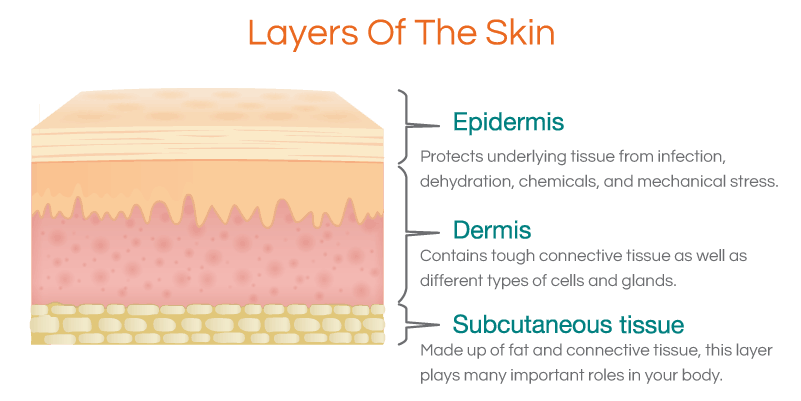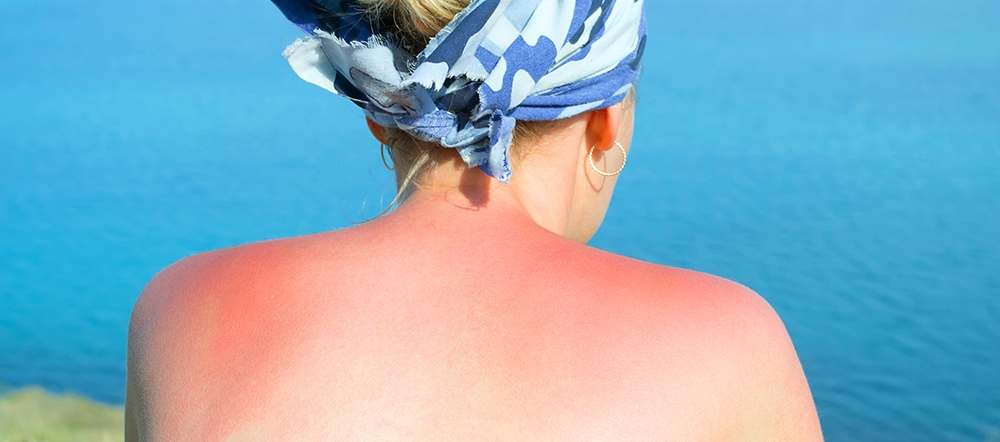Outdoor Tanning

What Are the Dangers of Outdoor Tanning?
Tanning is DNA damage. While you may like the look of tanned skin, it’s important to understand that the darkening of your skin is objective evidence of DNA damage.
The ultraviolet rays of the sun penetrate the skin’s epidermis and dermis, causing damage to the cells in both layers. The reason your skin becomes darker when it is exposed to the sun is that your skin produces melanin as a means of self-protection. The melanin migrates up from the space between the epidermis and dermis (where the pigment cells that produce melanin live) and serves as a shield for your skin, trying to help it avoid further sun damage. Your skin tans to protect itself from burning.

Don’t Burn To Tan
Some people desire the look of tanned skin so much they suffer through a sunburn to get to a tan. Sunburn occurs when your skin cannot produce melanin quickly enough to prevent UV rays from injuring the skin’s surface and the deeper blood vessels. Damage to blood vessels causes inflammation and swelling (which turns the skin red), as well as pain.

There are two phases of sunburn: the immediate and the delayed. Immediate sunburn causes the skin to turn a slight pink color, a result of the dilation of the blood vessels and the initial inflammatory response to too much sun. This immediate coloring is often the first warning sign that your skin is getting too much UV exposure. Delayed sunburn is a deeper and more severe damage caused to the blood vessels; the depth of damage is why you sometimes don’t see the burn until hours later. In fact, it can take up to 48 hours to see the full effect of some sunburns. Severe sunburns can cause enough inflammation that people become nauseated and sick. The most important thing to know is that every burn you receive, beginning in childhood, increases your risk of developing melanoma.
Every time you tan or burn, you damage the DNA in your skin. The more you damage your DNA, the greater your risk of developing melanoma, the deadliest form of skin cancer.
FACT: One or more blistering sunburns in childhood could double your lifetime melanoma risk.

Sun damage builds up over time, so even tanning every once in a while can have unintended consequences over the course of your lifetime. Cumulative sun exposure is linked to development of basal cell carcinoma, squamous cell carcinoma, and melanoma. Sunburns—especially blistering sunburns and especially if they occur before age 18—are also linked to the development of melanoma. Melanoma is the most serious form of skin cancer and causes the vast majority of all skin cancer deaths.
How Do I Protect My Skin From Sun Damage?
Sunscreen is the easiest way to protect yourself from the sun’s dangerous rays.
- Choose a broad-spectrum sunscreen that protects against both UVA and UVB radiation. Make sure it is water resistant and has a sun protection factor (SPF) of 30 or higher.
- Apply sunscreen liberally at least 15 minutes before going outdoors: Chemical sunscreens need 15 minutes to completely absorb into your skin to protect you. You need approximately one ounce (the amount in a shot glass) of sunscreen to cover your body.
- Use sunscreen even on cloudy days and during winter months.
- Reapply every two hours, even if the product is labeled “all day,” to ensure that you are well protected for the entire day.
- Remember that sweatproof or waterproof sunscreen does not exist—you should reapply after swimming, sweating, or toweling.
- Put sunscreen on all exposed areas. Don’t forget your ears, lips, face, feet, and neck.
Protective Clothing

Clothes can also protect your skin. Loose fitting garments made from fabric that is tightly woven provide good protection. Sun protection clothing—specially treated garments designed to filter ultraviolet rays—are also a great option. While technically all clothing can be considered sun-protective if it covers up the skin, look for clothing with a high (30+) Ultraviolet Protection Factor (UPF) rating for the best protection. A wide-brimmed hat that offers a lot of shade is the best choice for protecting head, face, and neck. Finally, wear UV protective sunglasses with a rating of UV400 or higher to protect your eyes.
How Much UV Reaches My Skin?
Your level of exposure to UV radiation depends upon the following factors:
| FACTOR | HOW MUCH RADIATION? | DID YOU KNOW? |
|---|---|---|
| Time of Day | Greatest when the sun is highest in the sky at midday, between 10 am and 4 pm. | How much UV exposure you’re getting can be measured by your shadow. If it’s shorter than you, then your exposure is high; if it’s taller, your exposure is lower. |
| Season | Greatest in late spring and early summer: from May to August in the Northern hemisphere and from November to February in the Southern hemisphere. | Exposure to sunlight during the winter months puts you at the same risk as exposure during the summertime, because UVA rays are present in daylight. |
| Geography | Strongest at the equator and in the tropics, where the sun is highest in the sky. | Weakens as you move towards the earth’s poles (both north and south). |
| Cloud Cover | Strongest on cloudless days. | Up to 80% of UV rays can penetrate light clouds, haze, and fog. |
| Reflecting Surface | The whiter the surface, the higher the UV level. Snow reflects the sun like a mirror. Light clothing is more reflective than dark clothing. | Fresh snow reflects up to 85% of the sun’s rays, nearly doubling your exposure. Sand and concrete reflect up to 12%. Grass and water reflect up to 5%. |
| Ozone Holes | Breaks in the protective ozone layer of the atmosphere significantly increase exposure to UV. | Holes exist over extremely cold areas, especially over the South Pole and the Arctic. |
| Length of Exposure | The longer you are out in the sun or on a tanning device, the more UV radiation you receive. | This includes any time spent outdoors, including walking, getting the mail, waiting for a train or bus, or playing an outdoor sport. |
*According to the National Weather Service
Medications That Cause Sensitivity to Sunlight
Certain medications increase your photosensitivity, or sensitivity to the effects of the sun. This sensitivity occurs when you are exposed to UV rays after you’ve ingested or applied a medication that contains an ingredient that becomes toxic when exposed to UV light. The reaction on your skin is called phototoxicity and can include increased burning, hives, rash, and even more serious reactions. A wide variety of topical and systemic drugs (such as some antibiotics and antihistamines) can cause photosensitive reactions, so it’s important to revisit whatever safety info you have and to talk with your doctor, who can let you know about potential risks.
| Type | Generic Name | Brand Name |
|---|---|---|
| Antibiotics | Tetracycline doxycycline ciprofloxacin sulfanomide | Achromycin, Sumycin Cipro Bactrim, Septra |
| Antihistamines | diphenhydramine cyproheptadine | Benadryl Periactin |
| Nonsteroidal anti-inflammatory drugs (NSAIDs) | Ibuprofen ketoprofen naproxen | Advil, Motrin Orudis, Oruvail Aleve, Anaprox Naprosyn |
| Diuretics | furosemide bumetanide hydrochlorothiazide | Lasix Bumex Esidrix, Hydrodiuril |
| Anticancer medications | dacarbazine vemurafenib methotrexate | DTIC Zelboraf Rheumatrex |
| Antiaging and acne medications | isotretinoin tretinoin | Accutane Retin-A |
| Antifungal medications | terbinafine | Lamisil |
| Hypoglycemics (treatment of type 2 diabetes) | glipizide glyburide | Glucotrol DiaBeta, Micronase |
| Oral contraceptives and estrogens | ethinyl estradiol and norgestrel conjugated estrogens estradiol | Lo/Ovral, Ovral Premarin Alora, Estroderm |
| Blood pressure and cardiovascular medications | amiodarone enalapril diltiazem quinidine | Cordarone, Vasotec Cardizem, Dilacor Quinidex Extentabs, Cardioquin |
| Psychiatric medications (tricyclic antidepressants, antipsychotic medications, antianxiety medications) | amitriptyline,imipramine, nortriptyline chlorpromazine alprazolam, diazepam | Elavil, Tofranil, Pamelor Thorazine, Ormazine Xanax, Valium |
*This is a partial list of some common medications only. Check the drug information sheets that come with your medications or contact your doctor to see if you need to take special precautions in the sun.

